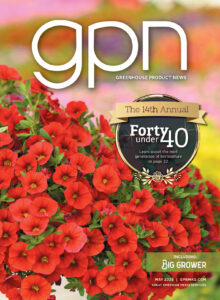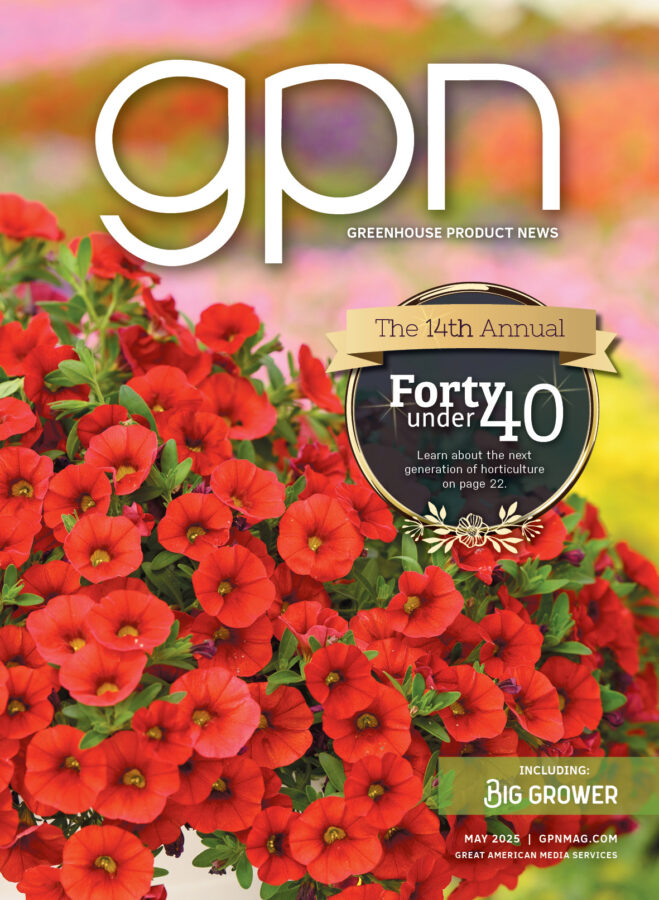
Aquaculture + Hydroponics = Aquaponics
Joining me this month is Todd Guerdat, assistant professor of agricultural engineering at the University of New Hampshire. Todd received his undergraduate degree from the University of North CarolinaWilmington in 1999. He then managed the North Carolina State University Fish Barn, Cooperative Extension’s commercial-scale demonstration, research, and training recirculating aquaculture facility. While at N.C. State, he earned his Master’s and Ph.D. degrees in Biological and Agricultural Engineering with emphasis on agricultural water and wastewater treatment. Todd’s research at UNH focuses integrating agricultural processes to optimize system efficiency and profitability.
Peter: Most of our readers are plantsmen so a good place to begin is describing the global challenges commercial fisheries are facing. Why is this topic relevant to growers, first as consumers and second as horticulturists?
Todd: Peter, an excellent question. Here are several facts that many find shocking. Over half of the seafood consumed worldwide is produced from aquaculture. Eighty percent of the seafood consumed in the U.S. is imported, by itself responsible for a nearly $11 billion domestic trade deficit. Global increase in seafood demand has triggered the birth of a new animal agriculture industry — aquaculture. The growth of global aquaculture coupled with growing demand has created concern over food security and quality for U.S. seafood consumption. At the same time, aquaculture growth in the U.S. has been stifled by siting challenges (location) and operating costs resulting in low profit margins and high risk.
Peter: OK Todd, this sounds familiar to what’s happening on the crop side of agriculture. The locally grown food movement’s mission is improving food security and quality using systems located close to consumption centers. The headline of our article is Aquaculture+ Hydroponics = Aquaponics. As simple as the equation looks, help us understand the potential benefits of marrying fish and plants as well as the challenges of combining them.
Todd: One big limitation in aquaculture is the management of fish wastes. Traditionally, wastes are captured, treated and discharged from aquaculture facilities. This represents a large cost for the operation and lost opportunity in terms of nutrient utilization. The essence of integration is the utilization of a waste from one system as a resource for another. But aquaculture wastes don’t integrate easily with terrestrial agriculture which is why we are looking at hydroponic cropping systems to receive these nutrients. Simply plugging one plumbing system into another and calling it integrated farming isn’t how it works, yet this is how many are approaching aquaponics in the DIY communities. Current research is looking at this from two perspectives; water treatment to accommodate the plant’s physiological requirements and overall system economics. We want to facilitate the treatment of the aquaculture wastes such that we meet the nutritional needs of the plants. Our goal is to balance the stoichiometry of the nutrients in our fish generated “fertilizer” solutions so we can grow plants at the same rates as conventional hydroponic growers. So far, we’ve done that with head lettuce at a pilot scale. We’re now scaling up and getting our processes ironed out at a farm-scale in our greenhouse research site here at UNH.
Peter: The difference in using terrestrial animal waste versus aquaculture waste in crop production appears to be the crux of the challenge. With integration of aquaculture and hydroponic systems in mind and given that early DIY systems are not yielding the profitability needed to solve the global seafood challenge, what aspects of system integration are you studying to solve the problem?
Todd: Aquaponic systems capitalize on the benefits of integration in a variety of ways, especially when we focus on a water treatment approach for developing nutrient solutions. How can we treat the fish waste stream to convert it into quality plant nutrition? Most of the nutrients needed for hydroponic production are present in the water, but aquaculture waste nutrients are not perfectly suited to hydroponic systems without conditioning. The biggest nutrient concern for hydroponic systems is organic carbon. The next concern is the relative proportions, stoichiometry, of nutrients available to the plants. Is there more nitrogen than a crop needs, too little potassium, too much or not enough of any minor element? We’ve demonstrated good stoichiometric analyses in the water in which the fish are cultured and we are working now on ways to condition the solid waste to develop a clarified nutrient solution. However, each nutrient source (liquid or solid waste stream) has more organic carbon than conventional hydroponic solutions. The inevitable result is microbial biomass accumulation, biofilm, in the system on the plant roots, grow bed surfaces, clogged emitters, etc.
Peter: Microbial contamination and biofilm are issues greenhouse growers deal with every day. An integrated system that shares water creates a whole new challenge; sanitation products used to treat crop irrigation water and delivery systems are probably not good for the fish. Let’s introduce the topic of coupled versus decoupled integrated aquaponic systems. I’m not a fan of zero sum propositions and believe as our research advances we may find applications for both system philosophies. What’s your vision of this part of the challenge?
Todd: Predicting where we go with integration requires a lot of patience. You and I have discussed a number of scenarios in which the nutrients from aquaculture supply the needs for hydroponic cropping systems. The devil of implementation is really in the details of the economic research. But the concept of a fish farmer also being a plant farmer, and vice versa, is a tough sell given the complexity of either of the systems individually. While a dairy farmer grows crops and cows, the waste from a dairy operation is captured and stored for a period of time before being applied to the fields. In aquaponic systems, the integration of the aquaculture and hydroponic systems creates a constant nutrient production and uptake balance that is year-round, day in and out. Both types of production, aquaponics and dairy, are doing the same thing — utilizing wastes as resources — however, the way in which the nutrient management plan gets implemented is drastically different. Ultimately, the goal is to allow everyone to specialize and thrive. What I mean by this is we are working on a way to allow each type of system to focus on its strengths. Fish farmers need to supply the much-needed seafood domestically but need a way to reduce the huge costs of waste treatment by creating a market for the treated nutrient solutions (think clean, clear nutrient solutions or even dried and premixed salts). Hydroponic operations would benefit from a nutrient source that is naturally derived for the sake of gaining organic (or similar) certification without the problems of organic carbon in the nutrient source. This means that instead of coupling our systems (the traditional model where fish and plants use the same treated water), we enable an avenue for nutrients to flow from one facility to the other without the burdens of dual system management. Decoupling the hydroponic and aquaculture systems means each system thrives and can manage their needs much more efficiently, ideally.
Peter: From my horticultural perspective there’s another issue in a coupled system that shares the same water between the fish and plants: pH management. Generally, fish require a higher pH than the types of plants we grow on the hydroponic side of the system. If one assumes that the higher level organism, the animal, should receive its optimal environment regarding pH then the plant side of the coupled system is going to be forced to tolerate a suboptimal growing environment. Growers are keenly aware of the effect drifting pH has on crop nutrient availability. From my plant-centric perspective a decoupled system approach makes a lot of sense. Remove the fish waste, treat it to remove organic carbon, adjust the pH, and use it on the hydroponic side. If a little tweaking to the stoichiometry is needed inject additional nutrients to deliver a perfect nutrient solution. Can this approach work?
Todd: Yes, but, aquaponic systems (coupled) are much more efficient in the utilization of nutrients than each of the systems operated separately. By integrating hydroponic cropping systems with recirculating aquaculture, the wasted nutrients (think nitrogen) are directly assimilated by the crops. This represents a cost savings as well as a reduction in what we discharge (water and nutrients), which means we spend money on growing a saleable product instead of treating wastes and simply discharging. The result is an improved production model because we’re potentially impacting the economics for both systems by monetizing aquaculture waste treatment and capitalizing on consumers being more conscious of where their food comes from, all tied up in a push for produce with an “organic” or similar certification. The crux to naturally and organically produced crops is the nutrient source; it almost always comes from animal agriculture … manure.
Peter: You just schooled me on why this challenge requires agricultural engineering, a tip of my cap. You did state earlier that overall system economics are holding back the initial DIY systems, thanks for reinforcing that fact. How about a final comment on this complex research topic?
Todd: Our research objectives are to develop a complete understanding of the nutrients produced from the aquaculture facility (nutrient mass balance), develop good agricultural practices (GAPs) for food safety, and evaluate different integrated pest management (IPM) strategies for microbes and insects. We will design integrated systems optimized under different production and/or economic constraints and build an economic strategy around integrating these two different systems (scale vs scope). We’re also planning on creating hands-on workshops annually for hydroponic, aquaponic and aquaculture producers with an engineering and biological focus covering the gamut of topics of integration.
Peter: This is an exciting project, Todd, and I am pleased to be one of your collaborators. I’m also confident that your growing group of graduate students is up to the challenge. Seeing that UNH is my undergraduate alma mater I get to close with a “Go Wildcats!”.
Photo caption: Graduate students Sean Fogarty and Anna Devitto are working with lettuce (foreground), strawberry (background) and Tilapia (fish tank) in a newly-constructed greenhouse range at a University of New Hampshire research farm.









 Video Library
Video Library 


















